Edward Charles Noakes
Private Edward Charles Noakes, 15th Battalion (2nd Birmingham Battalion), Royal Warwickshire Regiment
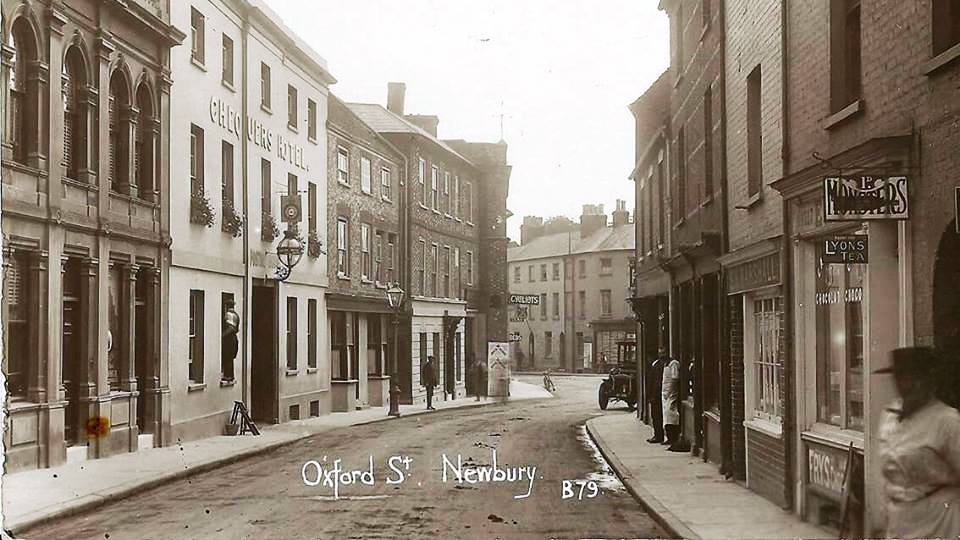
Oxford Street shortly before the war. The man in the white apron is standing at the doorway to the family boot-maker's shop - perhaps William senior stepping out to see what is going on?. |
Six more children were born in Newbury, in addition to Edward there were: Frances Hilda (born 1890), Reginald John (1891), Tom Stanley (1896), Frederick Gordon (1899) and Leslie Montague (1901). All but one (Frederick who died in 1900 before his first birthday) survived the very real risks of childhood disease and accidents.
The only surviving record of schooling for the entire family is that of Reginald’s time at the National School (St Nicolas) in Newbury between 1904 and 1906. This notes that he had previously attended the Newbury Wesleyan School – as there is other evidence that the family was Wesleyan Methodist it seems likely that all the children attended this school and, perhaps, the nonconformist British School in Newtown Road up until the minimum school leaving age of twelve. Apparently Edward only attended the Wesleyan School. One can only guess why Reginald was the only one to continue his education beyond this age; perhaps he was brighter or just enjoyed school more than the others?
Following his schooling Edward would have had the opportunity to learn his father’s trade as a boot and shoe maker – William and Tom both worked in the family business. However, Edward, if he ever tried, did not stick with shoe making, by 1911 he was working as a shop assistant in the furniture business of Joseph Hopson on the corner of Northbrook Street and West Street. Joseph’s son Paul would later marry Norah Camp and bring about a merger of Hopson’s business with her father Alfred Camp’s Drapery Bazaar to create the well known Newbury department store – Camp Hopson.
Evidently Edward was well suited to the job as he went on to manage furniture stores in Bournemouth and Aldershot.
When war broke out in August 1914 many young men rushed to recruitment offices, but not the Noakes brothers. Edward joined the army in April 1916 – a few months after he signed up (attested) under the Derby Scheme. This scheme, named after Lord Derby the minister for recruitment, encouraged men to sign up for future service as and when needed. Men were allocated a group, dependent on age and marital status; groups would be called up together, younger single men first. It was a final attempt to avoid the need to introduce conscription; although many men did sign up to the scheme the numbers were still too low and conscription was introduced even before the first group was called up. Edward’s group was among the first to be mobilised.
Following his training he was sent to France to serve in the 15th Battalion of the Royal Warwickshire Regiment. If his obituary in the local paper can be believed he crossed to France in June 1916 after only two or three months training (six months or more was typical).
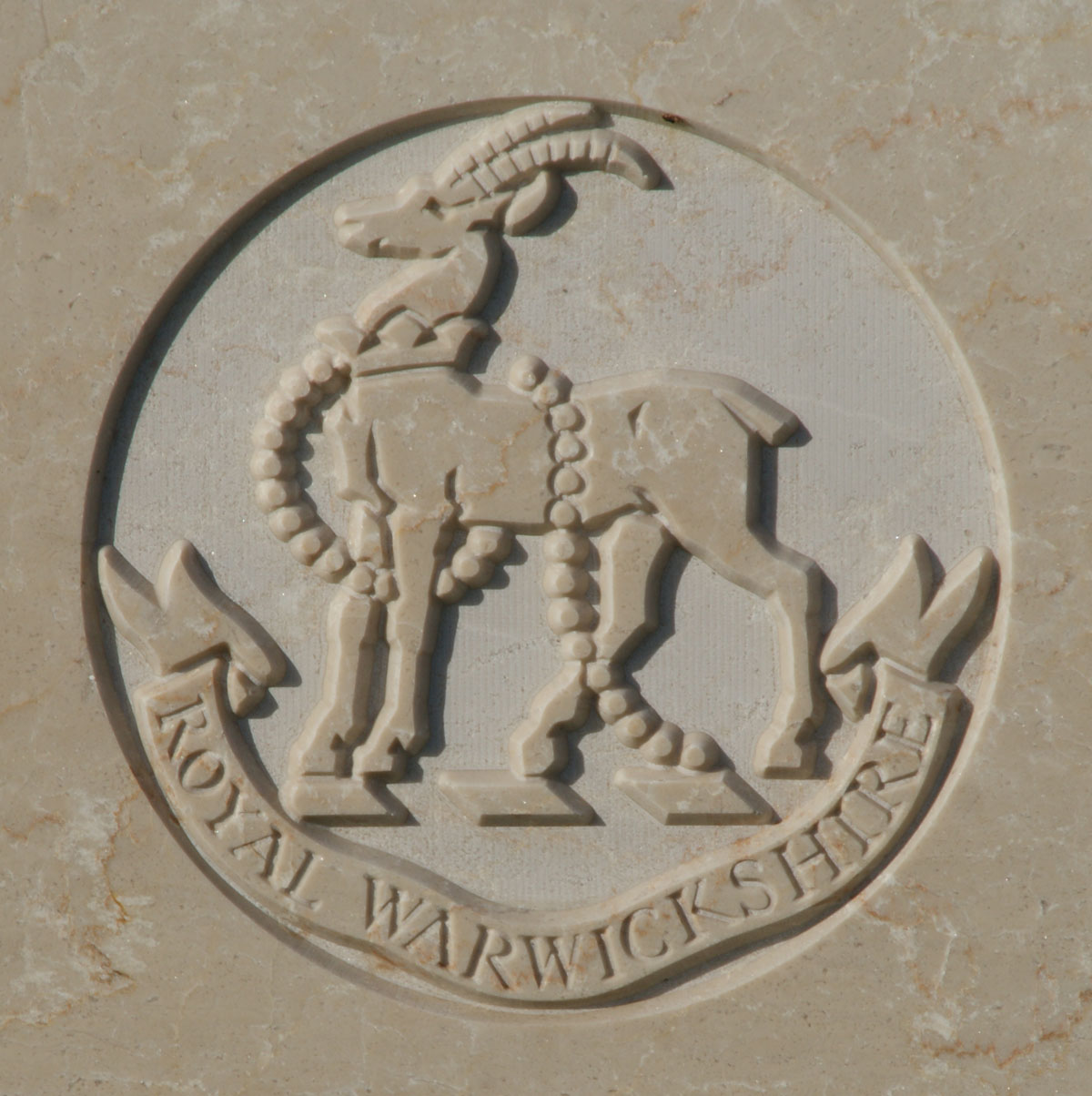
The regimental badge of the Royal Warkwickshire Regiment, as used on CWGC headstones. |
In Edward’s time with the battalion it saw action in the Battles of the Somme, Arras and Passchendaele going ‘over the top’ on a number of occasions and suffering many casualties. However, Edward survived all these bloodbaths, perhaps because he was given the role of stretcher bearer, though this arduous job was often carried out in very dangerous conditions. Yet, when the Division packed up for a move to the much quieter Italian front in late November 1917 Edward was no longer answering at roll call.
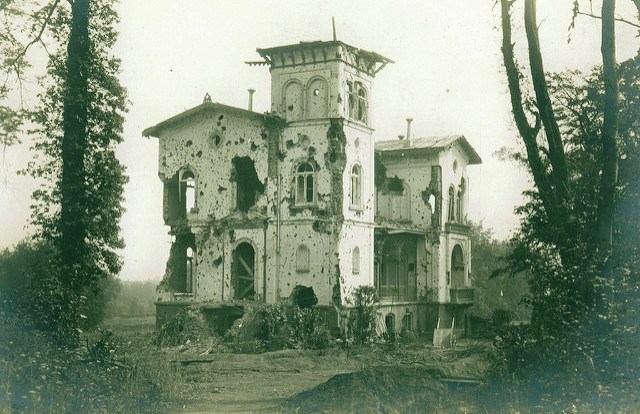
Polderhoek Chateau in 1915, before it was turned into a pile of rubble in 1917. (photo: Paul Reed - www.greatwarphotos.com) |
War Diary, 15th Battalion, Royal Warwickshire Regiment – 9 October 1917
| In Action. | At STIRLING CASTLE. |
| Zero hour 5.20am | Two companies C & D move up to close support during the morning |
| 9.10pm | 15th Infantry Brigade Operation Order 140 and Operation order 141/1 received with Zero Hour 11pm. |
| Remaining two companies and Battalion HQ move forthwith. | |
| Battn HQ J.14.d.95.40. Casualties: Other Ranks Killed 1, Wounded 5 |
The one man killed was Edward, hit by a shell fragment as he went about his duties as a stretcher bearer.
Newbury Weekly News, 18 October 1917 – Killed in Action
NOAKES. – Oct 9, in France, Pte Edward Charles Noakes, Royal Warwicks, third son of Mr and Mrs William Noakes, Oxford-street, Newbury, aged 24.
A short obituary was printed in the same edition:
Newbury Weekly News, 18 October 1917 – Local War Notes
Mr and Mrs William Noakes, of Oxford-street, have been greatly distressed by the receipt of the news of the death of their third son, Pte Edward Charles Noakes, stretcher bearer on the headquarters staff of the Royal Warwicks. The information was conveyed in a letter written by a comrade, who said Edward was struck by a small portion of shell about 9.30pm on the night of the 9th, and only lived a few moments. His end was quite peaceful, and he would not have been in pain, as he was struck in the region of the heart. The writer and another comrade carried him to a dug-out during a period of heavy shelling. He conveyed the deepest sympathy of the section. Pte Noakes was educated at the Wesleyan School, and was afterwards in the employ of Messrs Hopson and Sons. He subsequently managed secondhand furniture stores at Bournemouth and Aldershot. He joined up at the latter place, under the Derby Scheme, and had been in France fourteen months, expecting to obtain leave shortly. He was a member of Newbury Temperance Band, aged 24, married, but there are no children. Mr and Mrs Noakes have three other sons in France, William in the Queen’s Westminsters; Reginald, in the Army Ordnance Corps; Stanley, in the Royal Berks .
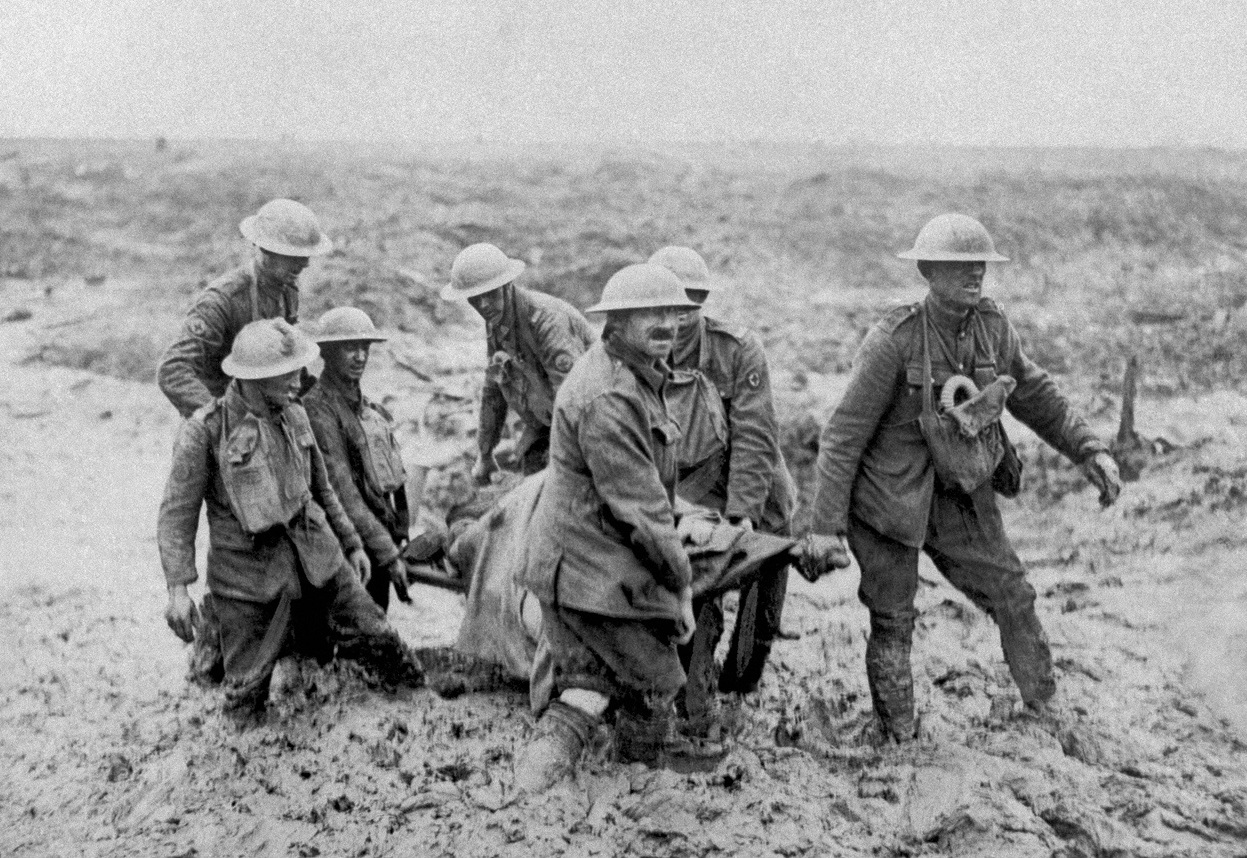
A stretcher party of seven men, struggling to get a single casualty to a treatment facility through the Passcehendaele mud. |
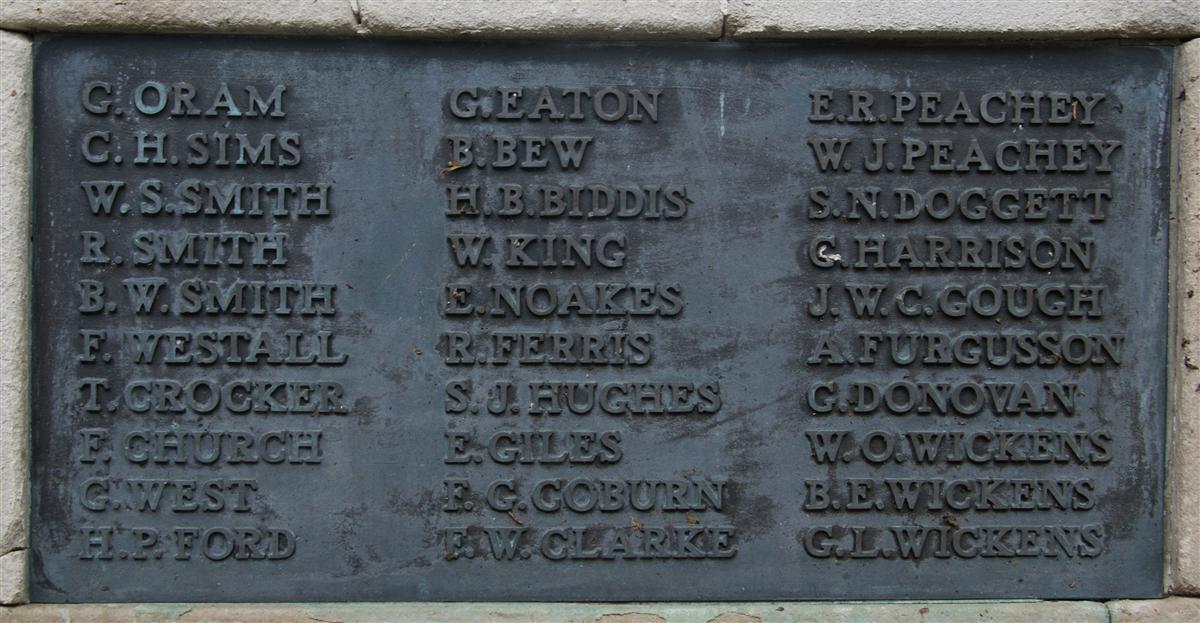
Edward's name on Newbury War Memorial (centre) |
He was, of course, not forgotten by his family:
Newbury Weekly News, 10 October 1918 – In Memoriam
In ever loving memory of Pte E C Noakes, stretcher bearer, 15th Royal Warwicks, who was killed while on duty in France, Oct 9th, 1917. Third son of Mr and Mrs W Noakes, Oxford Street, Newbury.
Dear son of our hearts, you sleep with the brave,
Where no tears of Mother can drop on your grave,
Unknown to this world you stand by our side,
And whisper “Dear ones, death cannot divide.
A loving son, a brother true and kind,
A beautiful memory he has left behind.
Family
William and Clara were parents of four sons of military age during the Great War. Three of Edward’s brothers served their country – not necessarily by choice:
William Clifford Noakes was definitely not wearing the khaki uniform by choice, he and his father made repeated attempts to avoid or, at least, delay his call-up after conscription as the following extracts from the local paper attest:
Newbury Weekly News, 16 March 1916 – Tribunals, Berkshire
William C Noakes, bootmaker, Newbury, had been granted two month’ exemption to arrange his business. Captain Partridge now appealed against this, but the two months were upheld.
Newbury Weekly News, 29 April 1916 – Tribunals, Newbury Borough
William Charles [sic - should be Clifford] Noakes appealed to the court in February, and was allowed two months exemption. The military authorities appealed, but the local decision was upheld. The father attended and said the two months would expire on April 19th, and his son had received notice to join up. A second appeal had been lodged that morning and leave was asked that it might be heard. The Tribunal agreed that there was a right of second appeal and that he would not be called up until it had been heard.
Newbury Weekly News, 4 May 1916 – Tribunals, Newbury Borough
A Second Appeal
Mt Thomas Willis, bootmaker of Bartholomew-street, and Mr William Noakes, of Oxford-street, put in a further appeal on behalf of W C Noakes, son of the latter, stating that the position was no better now that it was at the previous appeal. – Further exemption was granted until June 30th.
Newbury Weekly News, 18 May 1916 – Tribunals, Berkshire
The Military Representative appealed successfully against W C Noakes, bootmaker, of Newbury, being granted exemption until June 30th.
William’s efforts to avoid service were over – within days he was in the army. His entry in the medal roll for his British War Medal and Victory Medal shows that he served first in the 16th Battalion, London Regiment (Queen’s Westminsters) – number 6902 and then in the Labour Corps (224374). No further details of his service have survived, but from this one can surmise that he served overseas and was repatriated to the UK wounded or sick before the renumbering of the Territorial Force in early/mid 1917 - if he had been in a theatre of war at that time his medal roll entry would have included a new six-digit number for his service in the London Regiment (a Territorial unit). He then seems to have recovered, but not to full fitness and hence was transferred to the Labour Corps for further service overseas. While it is most likely that he served in France and Flanders it is possible that he served in one of the other theatres of war.
After the war William returned to Newbury and the family business and became a specialist maker of surgical boots (for which there was, sadly, a great demand following the war). On 31 July 1920 he married Alice Burgess in Tilehurst. The couple remained in Newbury until William’s death at Newbury Hospital on 19 October 1961, he was buried in Shaw Cemetery.
Reginald John Noakes served in the Royal Army Ordnance Corps (023859) remaining in the army longer than most, not being discharged until 20 November 1919. The role of the Army Ordnance Corps (the Royal was added in 1918) was to supply and repair weapons, munitions, armoured vehicles as well as some less obvious equipment (eg. laundries, mobile baths, photographic equipment). As such the majority of the personnel operated in relative safety behind the lines. The specific details of Reginald’s service are unknown.
After the war Reginald continued his association with the Royal Army Ordnance Corps working as a storeman. In 1924 he married Elizabeth May Quinn in York; perhaps he was working near there at the time. By 1939 he was working at the RAOC depôt in Basingstoke; he died there, aged 88, in 1980.
He had two children Brenda and Marion Thelma.
Tom Stanley Noakes enlisted in the local regiment, the Royal Berks, probably through the Derby Scheme in late 1915. He served in the regiment’s 6th Battalion in France probably joining it in 1916, perhaps in a draft making up for its losses on the opening day of the Battle of the Somme (when the battalion was a part of a successful attack on the village of Montauban). He remained with the 6th Battalion until it was disbanded in February 1918. Tom was among the majority of the 6th Battalion rank and file troops who were transferred to the 2nd Battalion of the same regiment.
In March 1918 the Germans launched a massive offensive against British positions on the Somme, the another around the River Lys just south of the Belgian border. The British Divisions in the line took a massive pounding but just managed to hold on after giving up a lot of territory. Several of the hardest hit divisions were moved south to a quiet sector in the line, coming under the command of the French Sixth Army. Needless to say this ‘quiet sector’ was where the Germans struck the next blow. The tired British divisions included the 8th Division of which the 2nd Battalion, Royal Berkshire Regiment was a part. The blow fell on 27 May when a dense fog aided the Germans, masking their advancing troops until they were almost in the British lines. The Berkshires fought stubbornly but eventually had to give way. In situations like this many men would be cut off alone or in small groups and would be captured. Tom was one of the men taken prisoner near the small village of Berry au Bac.
His family would have been notified that he was missing – a notification that was often followed by months of desperate hope and then a second notification that the missing man had been officially presumed dead. In Tom’s case the hope was fulfilled:
Newbury Weekly News, 7 November 1918 – Local War Notes
Mr and Mrs Noakes, of 20, Oxford-street, Newbury, received a post-card last week from their son, Tom, of the Royal Berks, who was missing on May 27th, to say he was a prisoner in the camp at Friedrichsfeld, near Waset, and that he was all right; and was anxiously awaiting a parcel.
A few days later the war was over and Tom returned home, arriving in late December. Tom worked as a shop assistant and was working at a gents’ outfitters in Salisbury in 1939, where he acted as an ARP warden during the second world war. In 1924 he married Anne Messer in Reading. The couple had one child, Dorothy, born in 1929. Tom died in Reading in 1972.
Sergeant 9515 Charles Alexander Newport, 5th Battalion, Royal Berkshire Regiment
Dividing line between this Bn and 7th Norfolks I.31.a.0.6, I.31.a.6.7, I.26.c.1.8.
The Battalion attacked at 4.25am on a three Company Front. C Coy on Right, D Coy in Centre, A Coy on Left – B Coy in Reserve.
All companies got close up under barrage and took their objective

